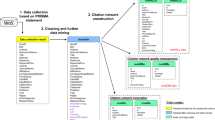Abstract
This paper discusses the appropriateness of literature-based innovation output indicators in the evaluation arena, and it sets forth criteria against which to judge such appropriateness.
Similar content being viewed by others
References
Acs, Zoltan J. and David B. Audretsch, 1993, ‘Analyzing Innovation Output Indicators: The U.S. Experience’, in Kleinknecht A. and D. Bain (eds.),New Concepts in Innovation Output Measurement, New York: St. Martin's Press.
Cogan, D. J., 1993, ‘The Irish Experience with Literature-based Innovation Output Indicators’, in A. Kleinknecht and D. Bain (eds.),New Concepts in Innovation Output Measurement, New York: St. Martin's Press.
Fleissner, P., Wolfgang Hofkirchner and Margit Pohl, 1993, ‘The Austrian Experience with Literature-based Innovation Output Indicators’, in A. Kleinknecht and D. Bain (eds.),New Concepts in Innovation Output Measurement, New York: St. Martin's Press.
Kleinknecht, A., 1993, ‘Testing Innovation Indicators for Postal Surveys: Results from a Five-County Project’, in A. Kleinknecht and D. Bain (eds.),New Concepts in Innovation Output Measurement, New York: St. Martin's Press.
Kleinknecht, Alfred and Donald Bain (eds.), 1993,New Concepts in Innovation Output Measurement, New York: St. Martin's Press.
Kleinknecht, Alfred, Jeroen O. N. Reijnen and Wendy Smits, 1993, ‘Collecting Literature-based Innovation Output Indicators: The Experience in the Netherlands’, in A. Kleinknecht and D. Bain (eds.),New Concepts in Innovation Output Measurement, New York: St. Martin's Press.
Lave, L. B., 1981,The Strategy of Social Regulations: Decision Frameworks for Policy, Washington, D.C.: The Brookings Institution.
Link, Albert N., 1993, ‘Evaluating the Advanced Technology Program: A Preliminary Assessment of Economic Impacts’,International Journal of Technology Management, Winter, pp. 726–739.
Link, Albert N., 1987,Technological Change and Productivity Growth, London: Harwood Academic Publishers.
Ormala, Erkki, 1989, ‘Nordic Experiences of the Evaluation of Technical Research and Development’,Research Policy, December, pp. 333–342.
Smith, V. Kerry, 1986, ‘A Conceptual Overview of the Foundation of Benefit-Cost Analysis’, in J. Bentkover, V. Covello and J. Mumpower (eds.),Benefit Assessment: The State of the Art, Dordrecht, Holland: Kluwer Publishers.
Steward, Fred, 1993, ‘Extracting Significant Innovations from Published Sources in Great Britain’, in Kleinknecht A. and D. Bain (eds.),New Concepts in Innovation Output Measurement, New York: St. Martin's Press.
Author information
Authors and Affiliations
Additional information
This paper was motivated by discussions with Zoltan Acs regarding new concepts in innovation output measurement and the implications of those concepts for small firms.
Rights and permissions
About this article
Cite this article
Link, A.N. The use of literature-based innovation output indicators for research evaluation. Small Bus Econ 7, 451–455 (1995). https://doi.org/10.1007/BF01112465
Accepted:
Issue Date:
DOI: https://doi.org/10.1007/BF01112465




